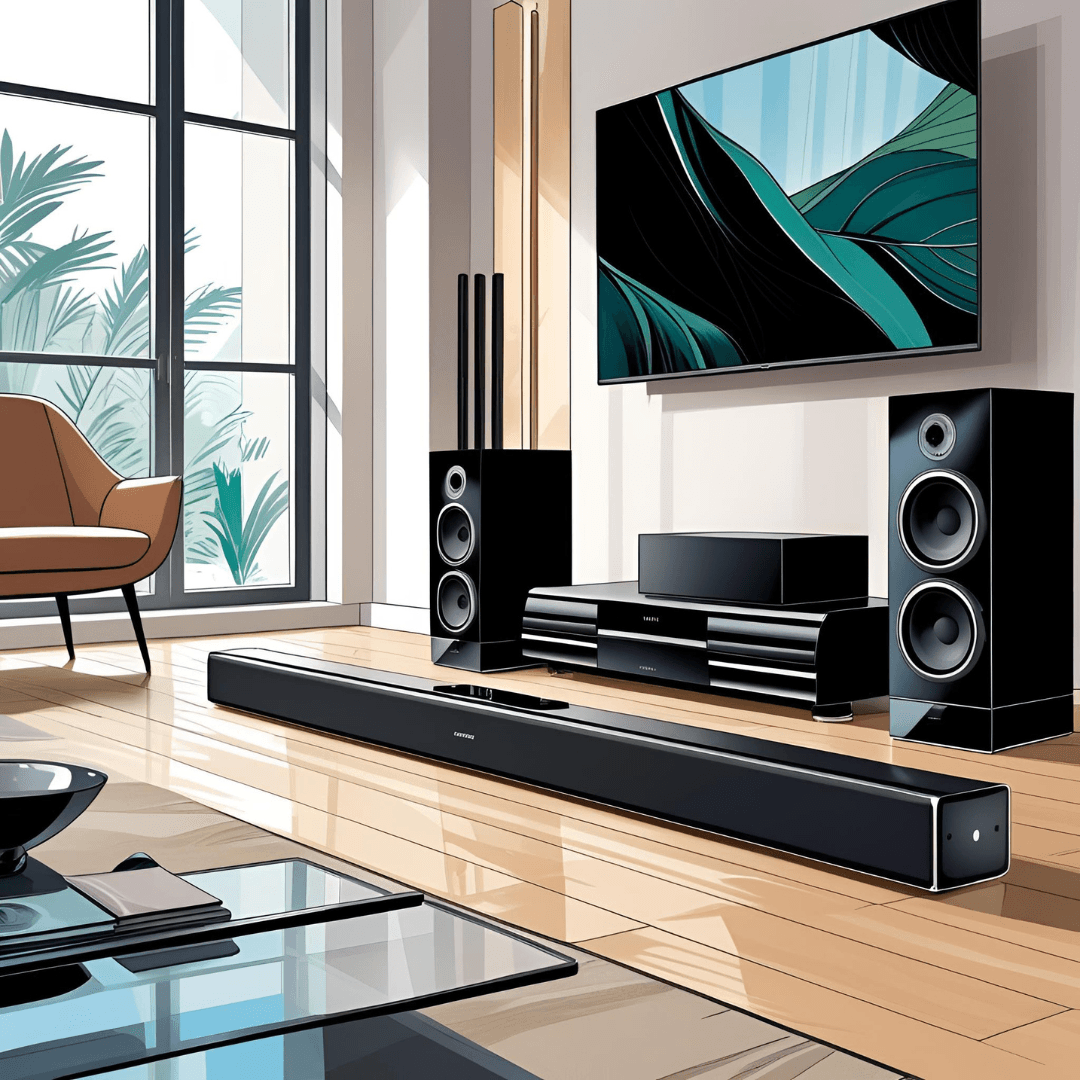
Soundbar vs Home Theater System: What’s the Difference?
Understanding the key differences between a soundbar and a home theater system can help you choose the best audio setup for your needs.
Soundbar
What it is: A compact, all-in-one speaker system typically placed below your TV.
Components: Usually includes multiple speakers built into a single bar (sometimes with a separate subwoofer).
Installation: Very easy to set up — great for small spaces.
Sound Quality: A noticeable improvement over built-in TV speakers, but less immersive than a full home theater.
Price: Generally more affordable.
Best for: Those who want better TV sound with minimal setup and wires.
Home Theater
What it is: A multi-speaker setup designed to deliver full surround sound.
Components: Includes front, rear, and center speakers, plus a subwoofer (and often an AV receiver).
Installation: More complex — speakers must be positioned around the room.
Sound Quality: True surround sound with high immersion, ideal for movies, gaming, and cinematic experiences.
Price: Typically more expensive.
Best for: Those seeking a full cinematic audio experience at home.
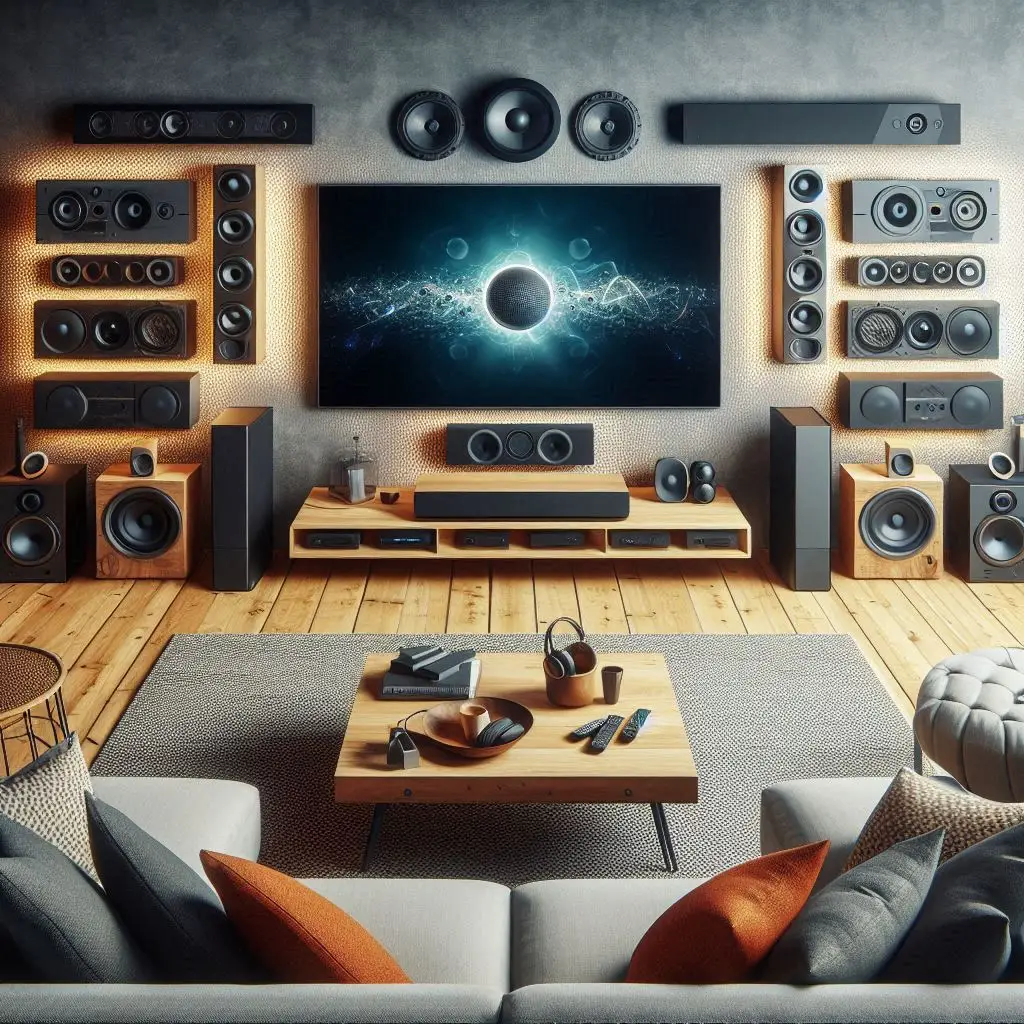
🔍 Quick Comparison:
| Feature | Soundbar | Home Theater |
|---|---|---|
| Structure | Single soundbar | Multiple speakers |
| Setup | Very easy | More complex |
| Audio immersion | Moderate | High (true surround) |
| Space required | Minimal | Requires more room |
| Average price | Lower cost | Higher cost |
| Best suited for | Everyday TV viewing | Home cinema and immersive experiences |
Soundbar vs Home Theater System
Modern televisions are marvels of visual technology, offering stunningly thin profiles and vibrant displays. However, this pursuit of sleek aesthetics often comes at a significant cost: their built-in audio. The tiny, downward-firing speakers packed into slim TV frames rarely deliver the immersive, rich sound that truly complements today’s high-definition content. This makes an audio upgrade almost mandatory for a complete home entertainment experience.
When it comes to boosting your living room audio, two primary options stand out: soundbars and full-fledged home theater systems. Both promise a dramatic improvement over your TV’s native speakers, but they achieve this through fundamentally different approaches, catering to distinct needs and preferences. This comprehensive guide will help you understand the nuances, pros, and cons of each, empowering you to choose the best option for your home and listening habits.
We’ll dive deep into their design philosophies, audio performance capabilities, setup complexity, cost considerations, and ideal use scenarios to help you make an informed decision.
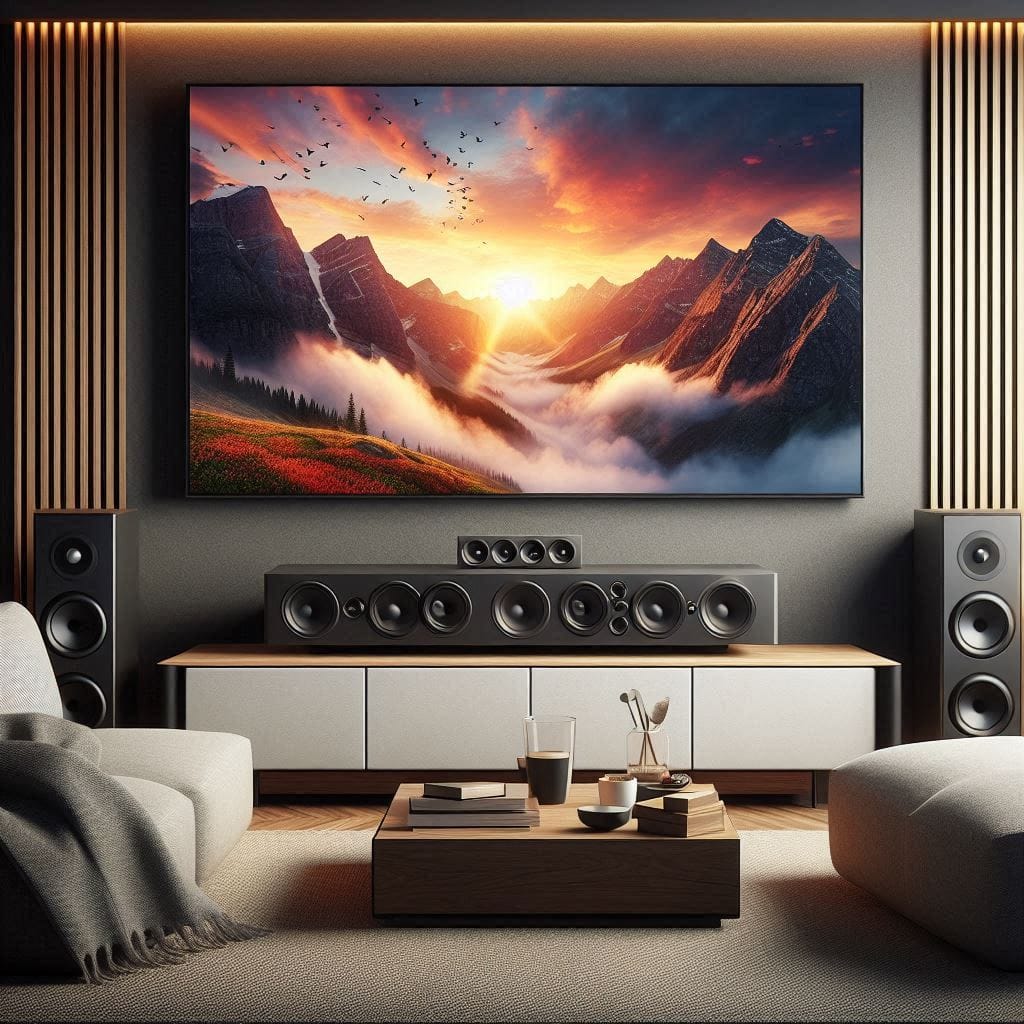
Contender 1: The Soundbar – Simplicity Meets Enhancement
A soundbar is a sleek, self-contained unit designed to fit discreetly below your television. It packs multiple speakers and amplification into a single, compact enclosure, often accompanied by a wireless subwoofer for enhanced bass. It’s the go-to solution for those seeking a significant audio upgrade without the clutter.
Pros:
- Simplicity: Known for its easy installation—often a simple plug-and-play setup—with far fewer cables and components than a traditional home theater system.
- Minimalist Design: Its compact, elongated form factor integrates seamlessly below your TV, making it ideal for modern, minimalist living spaces and smaller rooms.
- Cost-Effectiveness (Initial): Generally more affordable at the entry-level, offering a quick and noticeable improvement over TV speakers without a huge investment.
- Immediate Improvement: Provides a gigantic leap in audio quality compared to built-in TV speakers, offering clearer dialogue, broader sound, and more impactful bass.
- Connectivity: Modern soundbars come equipped with versatile connectivity options like Bluetooth, Wi-Fi, and HDMI ARC/eARC, ensuring easy integration with your TV and other smart devices.
Cons:
- Limited Immersion: Even with advanced virtual surround sound technologies (like Dolby Atmos and DTS:X processing), the perception of sound coming from behind or above you is simulated, not real. True channel separation is inherently limited by being a single bar.
- Limited Scalability: Many soundbar models are “closed” systems, making it difficult or impossible to upgrade individual components or expand channels beyond their initial configuration (though some modular systems allow adding rear surrounds).
- Power Limitations: While powerful for their size, some soundbars may reach their limits in very large rooms or at extremely high volumes, potentially lacking the dynamic headroom of a dedicated system.
Ideal Scenario:
Soundbars are perfect for apartments, small to medium-sized living rooms, and anyone who prioritizes simplicity, clean aesthetics, and a significant audio upgrade for their TV without any setup complications.
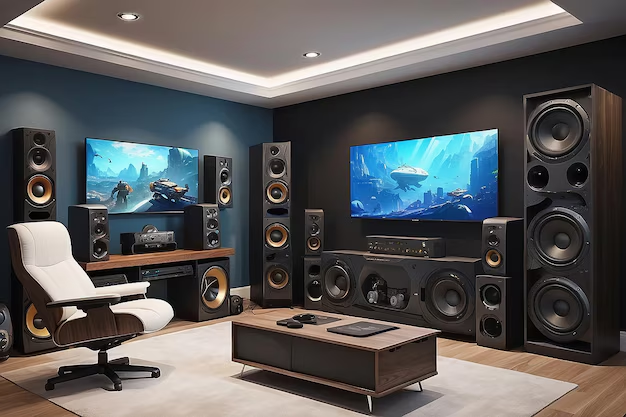
Contender 2: The Home Theater System – The Full Cinematic Experience
A home theater system represents the traditional, uncompromised approach to immersive audio. It consists of multiple separate components: an A/V receiver (which acts as the central hub for all your audio and video sources), individual speakers positioned strategically around the room (front left/right, center, surround left/right), and a dedicated subwoofer. Optionally, it can include height speakers for truly three-dimensional formats like Dolby Atmos.
Pros:
- Superior Immersion (True Surround): With discrete speakers precisely positioned around your environment, a home theater system delivers accurate, genuine positional audio, creating a complete sonic bubble that truly places you inside the action. Sound actually comes from behind and above you, not just virtually.
- Optimized Audio Quality: Each speaker is meticulously designed for a specific function (e.g., dedicated center channel for dialogue clarity), resulting in greater fidelity, dynamic range, and clarity across the entire frequency spectrum.
- Scalability and Flexibility: This is a major advantage. You have the ability to upgrade individual components, add more channels (5.1, 7.1, 5.1.2 Atmos, etc.), or replace speakers piece by piece as your needs or budget evolve.
- Advanced Features: A/V receivers offer a wealth of advanced features, including multiple HDMI inputs for all your devices, sophisticated room calibration technology (like Audyssey or Dirac), advanced video processing, and extensive audio customization options.
Cons:
- Complexity: Installation and configuration are significantly more complex, involving numerous cables, speaker placement optimization, and often an initial calibration process.
- Space and Aesthetics: A home theater system requires more physical space for its multiple components and can be visually more imposing in a living room, especially with exposed cables.
- Higher Initial Cost: Generally represents a larger initial investment for a decent quality system compared to an entry-level soundbar.
- WAF (Wife Acceptance Factor): (Lighthearted but real!) The aesthetics and number of components can sometimes be a point of discussion for those sharing the living space.
Ideal Scenario:
Home theater systems are ideal for dedicated listening rooms or large living spaces, audiophiles, and cinema enthusiasts who demand the absolute best and most immersive audio experience possible, and who don’t mind the complexity of setup and cable management.
Head-to-Head Comparison: Soundbar vs. Home Theater System
For a quick reference, here’s how the two contenders stack up:
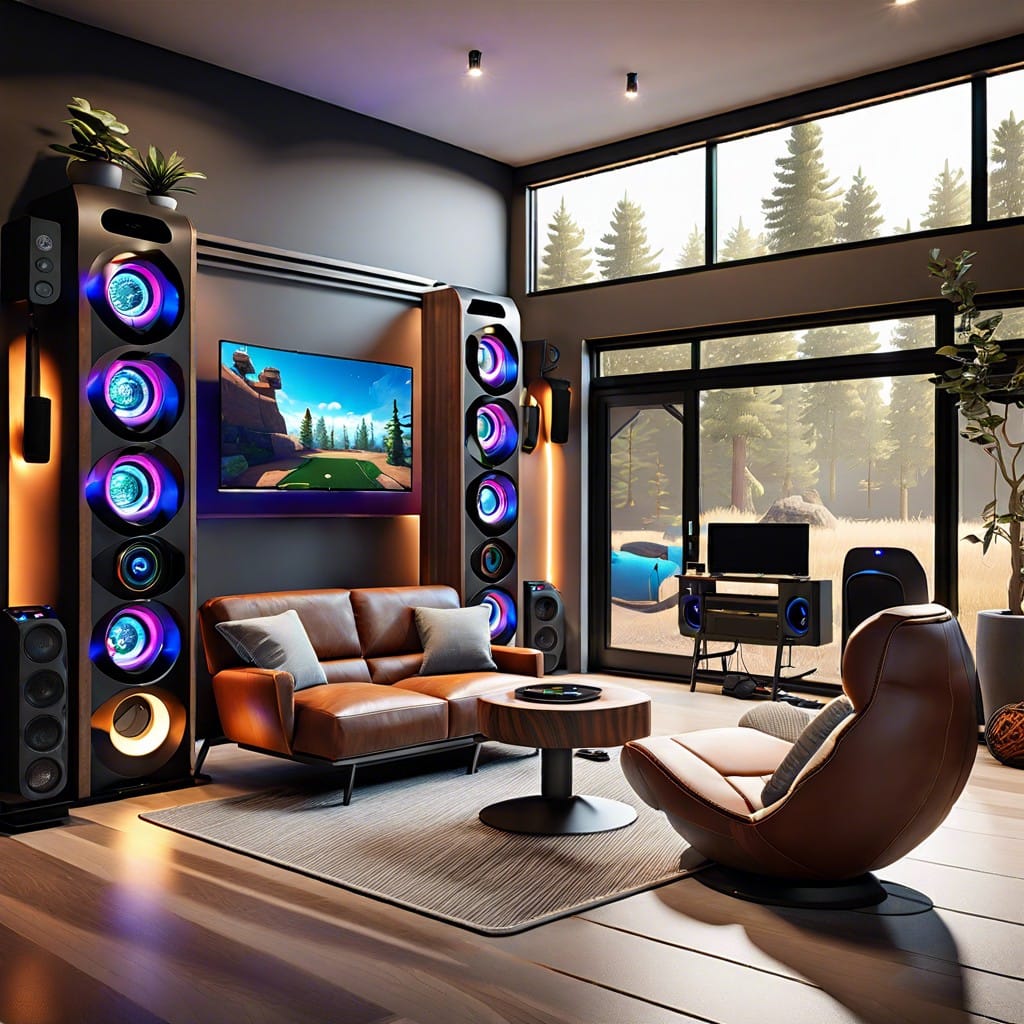
Taking the Next Step: Making Your Decision
Choosing between a soundbar and a home theater system requires honest self-assessment of your needs and limitations. Consider these crucial factors:
- Consider Your Room Size: A soundbar can be perfectly sufficient for a small to medium-sized living room. Larger rooms, however, will benefit immensely from the increased power, dispersion, and immersive capabilities of a multi-speaker home theater system.
- Your Budget: Be realistic about your spending. While high-end soundbars can compete with entry-level home theater systems, a truly premium home theater setup will always demand a significantly higher investment.
- Desired Level of Immersion: Do you just want noticeably better audio than your TV’s built-in speakers, or do you crave a truly enveloping, cinematic experience that places you right in the middle of the action?
- Tolerance for Complexity and Cables: Are you comfortable with more wiring, multiple components, and potentially some calibration, or do you prefer a simple, out-of-the-box solution?
- Lifestyle and Aesthetics: Is a minimalist, clutter-free setup essential for your living space, or do you have the room and appreciate the visual presence of multiple speakers?
Conclusion: Your Audio Journey, Your Choice
Both soundbars and full home theater systems are excellent ways to dramatically improve your living room audio, but they offer fundamentally different value propositions. The soundbar wins on simplicity, space-saving design, and immediate gratification, making it ideal for casual listeners and smaller spaces. The home theater system, on the other hand, delivers unparalleled immersion, sonic fidelity, and future-proofing, catering to dedicated enthusiasts with larger rooms and a desire for the ultimate cinematic experience.
Your audio journey is unique, and the best choice is the one that aligns perfectly with your priorities. Weigh the pros and cons of each, considering your room, budget, desired immersion, and willingness to tackle complexity.
Whatever your choice, prepare to transform your living room into a true auditory entertainment hub. The days of tinny TV sound are over!

Further Resources: Optimizing Your Home Entertainment Audio
To further enhance your understanding and setup of home audio, explore these additional resources:
📚 Internal Links: More from Gear For Audio
- Top Home Theater Systems: Dive deeper into dedicated setups with The Best Home Theater Systems of 2025
- High-Resolution Audio: Learn about the source of quality sound with Hi-Res Audio Gear 2025
- Studio Monitor Speakers: Understand speaker quality principles with Best Studio Monitor Speakers 2025
- Affordable Hi-Fi: Discover how to achieve great sound on a budget with Affordable Hi-Fi Headphones
- Audio Cables & Adapters: Ensure proper connectivity with our Audio Cables and Adapters Guide
- Audio Gear Care: Keep your equipment pristine with The Unsung Hero of Audio Quality & Longevity
- Home Studio Accessories: Explore more ways to upgrade your audio setup with Top Audio Accessories for Home Studios in 2025
🔗 External Links: Industry Standards & Expert Insights
- Dolby Atmos Official Site: Learn about the immersive audio technology that brings sound to life: Explore Dolby Atmos
- DTS Official Site: Discover another leading technology for cinematic audio experiences: Learn about DTS:X
- Denon A/V Receivers: Explore a popular brand for home theater receivers that act as the central hub of your system: Visit Denon
- RTINGS.com – Soundbar Reviews: A highly technical review site offering in-depth analysis and comparisons of soundbars: See Soundbar Reviews on RTINGS.com
- Crutchfield – Home Theater Buying Guide: A trusted retailer offering comprehensive guides on setting up home theater systems: Read Crutchfield’s Guide

